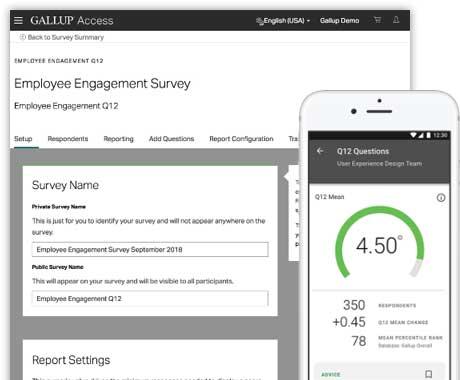Engaged employees are rare. Gallup's most recent global research finds 21% of employees worldwide are engaged at work.
Engaged workers stand apart from their not engaged and actively disengaged counterparts because of the discretionary effort they consistently bring to their roles. These employees willingly go the extra mile, work with passion, and feel a profound connection to their company. They are the people who will drive innovation and move your business forward.
Contrast this with actively disengaged employees, who are more or less out to damage your company. Not only are they unhappy at work, but they are intent on acting out their unhappiness. They monopolize managers' time and drive away customers. Whatever engaged employees do -- such as solve problems, innovate, and create new customers -- actively disengaged employees will work to undermine.
The majority of the global workforce is not engaged: most employees reluctantly head to work, lacking energy and passion for their jobs.
Not-engaged employees offer perhaps the greatest untapped opportunity for businesses to improve their performance and profitability. Not-engaged workers can be difficult to spot. They are not overtly hostile or disruptive and likely do just enough to fulfill their job requirements. They sleepwalk through their day, uninspired and lacking motivation. They have little or no concern about customers, productivity, profitability, safety, or quality. They are thinking about lunch or their next break and have essentially "checked out."
The majority of the global workforce is not engaged: most employees reluctantly head to work, lacking energy and passion for their jobs. Converting this group of employees into engaged workers is the most effective strategy that any organization can implement to increase performance and sustainable long-term growth.
Improving employee engagement strategies should be a priority.
Measuring employee engagement is important. Measuring the right things -- those that matter most to performance and provide a framework for positive change -- is crucial. Gallup's Q12 employee engagement measurement tool is designed to initiate companywide transformation to create sustainable growth. This tool is backed by rigorous science linking it to nine integral performance outcomes.
Every two to four years, Gallup completes meta-analysis research -- a statistical technique that pools multiple studies -- on the Q12. In 2020, Gallup conducted its 10th meta-analysis on the Q12 using 456 research studies across 276 organizations in 54 industries and 96 countries. Within each study, Gallup researchers statistically calculated the work-unit-level relationship between employee engagement and performance outcomes that the organizations supplied.
Researchers studied 112,312 work units, including more than 2.7 million employees. This latest iteration of the meta-analysis further confirmed the well-established connection between employee engagement and key performance outcomes:
- customer ratings
- profitability
- productivity
- turnover (for high-turnover and low-turnover organizations)
- safety incidents
- shrinkage (theft)
- absenteeism
- patient safety incidents
- quality (defects)
When Gallup analyzed the differences in performance among work units, the benefits of employee engagement were clear. When comparing employee engagement levels, Gallup found that top- and bottom-quartile business units and teams had stark differences in business outcomes, including a 23% difference in profitability and a 43% difference in turnover in low-turnover organizations.
The 2020 meta-analysis verified once again that employee engagement relates to each of the nine performance outcomes studied. Gallup also finds that the strong correlations between engagement and performance are highly consistent across different organizations from diverse industries and regions of the world.
How to Increase Employee Engagement: Build a Constituency
Though important at the organizational level, engagement starts with each person and is subjective. Employees don't check their personalities at the door when they come to work. Knowing that they are respected as individuals at work can have a significant impact on how employees view their overall lives.
If employees truly are a company's best asset, then leaders and managers should make caring for them a priority.
Each person's potential extends well beyond his or her job description. And tapping that potential means recognizing how an employee's unique set of beliefs, talents, goals, and life experiences drives his or her performance, personal success, and wellbeing.
Managers and leaders should know their people -- who they are, not just what they do. Every interaction with an employee has the potential to influence his or her engagement and inspire discretionary effort. How leaders manage their employees can substantially affect engagement levels in the workplace, in turn influencing the company's bottom line. Here are five employee engagement strategies organizations can use to help build their constituency of engaged employees:
1. Use the right employee engagement survey.
When a company asks its employees for their opinions, those employees expect action to follow. But businesses often make the mistake of using employee surveys to collect data that are irrelevant or impossible to act on. Any survey data must be specific, relevant, and actionable for any team at any organizational level. Data should also be proven to influence key performance metrics.
2. Focus on engagement at the local and organizational levels.
Real change occurs at the local workgroup level, but it happens only when company leaders set the tone from the top. Companies realize the most benefit from engagement initiatives when leaders weave employee engagement into performance expectations for managers and enable them to execute on those expectations. Managers and employees must feel empowered to make a significant difference in their immediate environment.
Leaders and managers should work with employees to identify barriers to engagement and opportunities to effect positive change. Employees are familiar with the company's processes, systems, products, and customers. They are also experts on themselves and their teams. So it makes sense that they will have the best ideas to maximize these elements and deliver improved performance, business innovation, and better workplace experiences.
3. Select the right managers.
The best managers understand that their success and that of the organization relies on employees' achievements. But not everyone can be a great manager. Great managers care about their people's success. They seek to understand each person's strengths and provide employees with every opportunity to use their strengths in their role. Great managers empower their employees, recognize and value their contributions, and actively seek their ideas and opinions.
It takes talent to be a great manager, and selecting people who have this talent is important. Whether hiring from outside or promoting from within, businesses that scientifically select managers for the unique talents it takes to effectively manage people greatly increase the odds of engaging their employees. Companies should treat the manager role as unique, with distinct functional demands that require a specific talent set.
4. Coach managers and hold them accountable for their employees' engagement.
Gallup's research has found that managers are primarily responsible for their employees' engagement levels. Companies should coach managers to take an active role in building engagement plans with their employees, hold managers accountable, track their progress, and ensure that they continuously focus on emotionally engaging their employees. The most successful managers view the Q12 as the elements for great managing, not just questions for measuring. By doing so, they gain a powerful framework to guide the creation of a strong, engaged workplace.
5. Define engagement goals in realistic, everyday terms.
To bring engagement to life, leaders must make engagement goals meaningful to employees' day-to-day experiences. Describing what success looks like using powerful descriptions and emotive language helps give meaning to goals and builds commitment within a team. Make sure that managers discuss employee engagement at weekly meetings, in action-planning sessions, and in one-on-one meetings with employees to weave engagement into daily interactions and activities and to make it part of the workplace's DNA.
Leaders in the best companies strategically align their employee engagement efforts. They find ways to communicate engagement's effect throughout the year and share best practices across the organization. They use every opportunity, touchpoint, and communication channel to reinforce and recognize the organization's commitment to employee engagement. They integrate employee engagement fully into the business' lexicon.
If employees truly are a company's best asset, then leaders and managers should make caring for them a priority. Organizations have a valuable opportunity to transform their employees' work experiences into ones that are fulfilling and motivating -- and that allow workers to bring their best to work every day.
Learn how to engage employees:
- Explore Gallup's research and advice on improving business outcomes through employee engagement.
- Invest in the people who are responsible for 70% of the variance in employee engagement: your managers.
- Get the metrics that matter and advice for what to do with them with Gallup Access.






